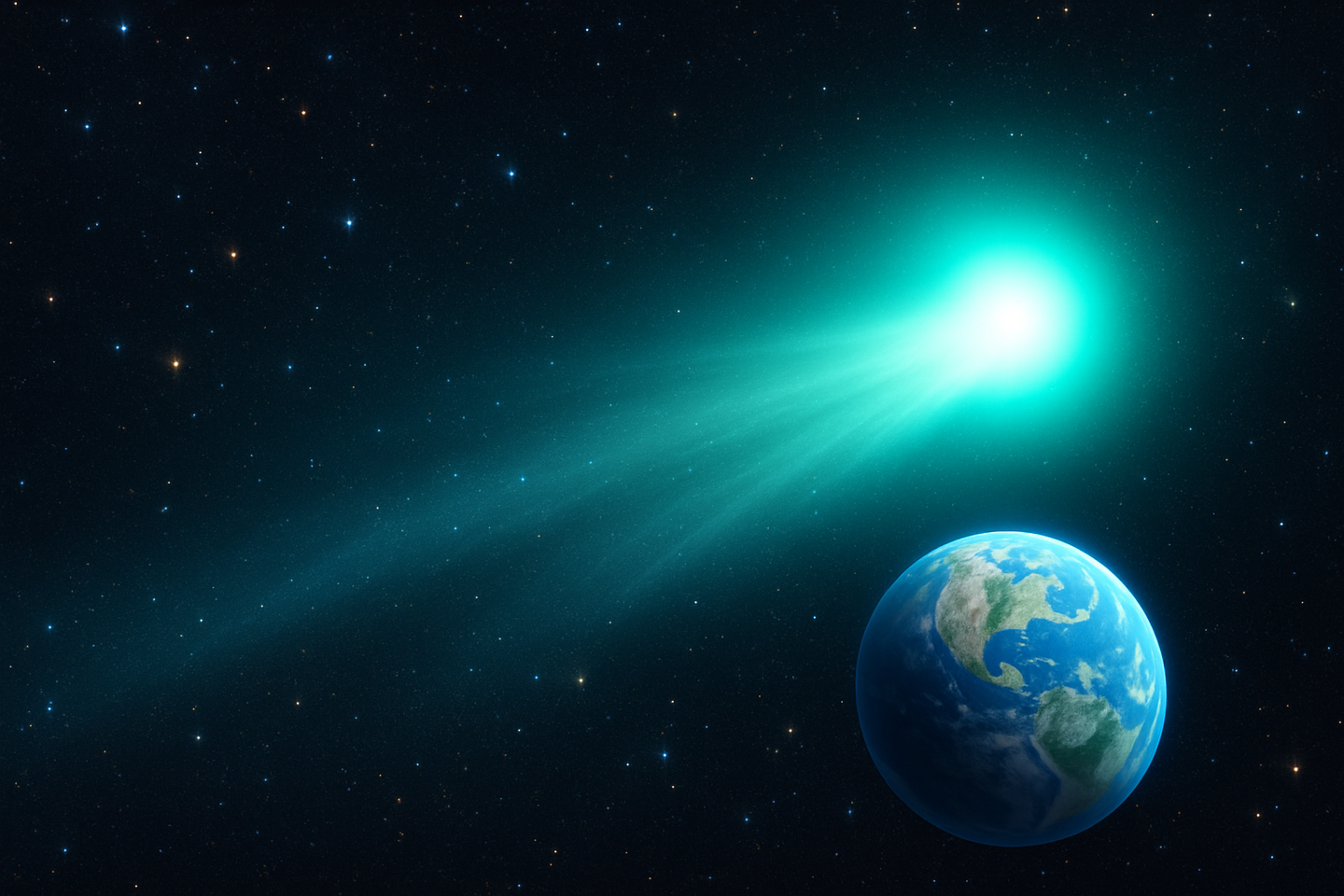Astronomers intrigued by odd light emitted by interstellar visitor 3I/ATLAS
Some believe 3I/ATLAS might be something far more unusual—perhaps even technology built by another civilization.

Astronomers are puzzled by 3I/ATLAS, the third interstellar visitor to our solar system. (CREDIT: AI-generated / The Brighter Side of News)
Astronomers have spotted only three objects known to have come from outside our solar system. The newest, called 3I/ATLAS, is already raising eyebrows. First seen this summer, it doesn’t quite behave like a comet, and that’s what makes it so fascinating.
Some researchers say it’s just an icy traveler from deep space, while others believe it might be something far more unusual—perhaps even technology built by another civilization.
What the Telescope Saw
NASA’s Hubble Space Telescope captured the clearest image so far of 3I/ATLAS on July 21, 2025. The picture showed a glowing haze, known as a coma, shining ahead of the object as it moved toward the Sun. That’s typical for comets when heat vaporizes their icy surfaces. What’s not typical is what’s missing: there’s no bright tail trailing behind it, the sort you’d normally expect. Instead, the glow appears focused like a beam of light in front of its path.
Harvard University astrophysicist Avi Loeb, never shy about offering bold ideas, pointed out that the brightness doesn’t match what sunlight reflecting off dust should look like. In fact, the steep brightness curve suggests most of the light is coming directly from the nucleus itself. If that’s true, the object may be much smaller than earlier estimates, perhaps less than 100 meters across—similar in size to the two other interstellar visitors, ‘Oumuamua and 2I/Borisov.
Could It Be Generating Its Own Light?
This unusual brightness has led Loeb and his colleague Eric Keto to consider a daring possibility: the object might be producing its own light. That would separate it from ordinary comets and asteroids. Loeb calculated that the glow requires about 10 gigawatts of power, comparable to the output of a large power plant on Earth. Sunlight reflection alone cannot explain the observed profile.
So what could provide such energy? Loeb explored several options. A tiny black hole, radiating energy through Hawking radiation, would generate only a fraction of the needed power. A shard from a supernova’s core rich in radioactive materials could fit, but such fragments are considered extraordinarily rare.
The most adventurous explanation is that 3I/ATLAS might be a spacecraft powered by nuclear energy, shedding dust it collected during its long journey across interstellar space.
Related Stories
- Scientists discover mysterious object that may be the oldest comet ever detected
- Vesta might be much more than an asteroid, astronomers find
“This cannot be ruled out,” Loeb wrote, “but requires better evidence to be viable.” Still, it’s hard to ignore that the object seems to glow without a comet-like tail, leaving scientists puzzled.
A Curious Path Through the Solar System
Beyond its glow, 3I/ATLAS has also taken an unusual route. It has passed close to both Earth and Jupiter on its way inward, almost as though it’s weaving its way through our neighborhood. Later this year, on October 3, it will pass within about 29 million kilometers of Mars—a close shave in astronomical terms.
This timing presents an extraordinary chance for a closer look. NASA’s Mars Reconnaissance Orbiter, equipped with the HiRISE camera, is already scheduled to train its instruments on the object during its flyby. Observing from Earth around the same time will be tricky since the object will appear close to the Sun in the sky. But the orbiter could provide new data that may solve some of the mystery.
Scientific Debate Heats Up
Most astronomers remain cautious, leaning toward the idea that 3I/ATLAS is a comet behaving in an odd way. David Jewitt, who analyzed the Hubble images, noted that evaporation from the Sun-facing side could explain the coma and the absence of a tail. Tiny ice particles could sublimate quickly, disappearing before they have time to form a streak.
But the steep light profile still troubles some researchers. Normally, sunlight bouncing off dust creates a gentler decline in brightness. Instead, this object shows a rapid falloff, which fits better with a compact light source at the center. Loeb insists the simplest interpretation is that the nucleus itself is luminous.
The debate echoes past controversies. When ‘Oumuamua swept past in 2017, Loeb argued it could have been an alien probe, a suggestion that divided the scientific community. Now, with 3I/ATLAS, he once again presses the question of whether we’re seeing technology, not just rock and ice.
Waiting for October
For now, the mystery continues. The next few months will be crucial, as the Mars flyby offers the best opportunity to gather detailed images. Whether it turns out to be a comet, a radioactive shard, or something built by an unknown intelligence, 3I/ATLAS is already sparking lively discussions about how much we still don’t know about the universe.
Loeb seems undeterred by skepticism. His persistence reflects the wonder and curiosity that discoveries like this inspire, whether they confirm old ideas or shake up our understanding entirely.
Practical Implications of the Research
If 3I/ATLAS truly generates its own light, it could change how scientists think about interstellar debris. It may suggest there are sources of radioactive fragments drifting between stars, which would expand our knowledge of stellar explosions and material distribution in the galaxy.
On the other hand, if the object is found to be technological in origin, it would raise profound questions about whether civilizations beyond Earth have been exploring the cosmos long before us. Either way, the discovery pushes astronomy toward sharper instruments, bolder missions, and a deeper willingness to ask difficult questions about what lies beyond our solar system.
Note: The article above provided above by The Brighter Side of News.
Like these kind of feel good stories? Get The Brighter Side of News' newsletter.



